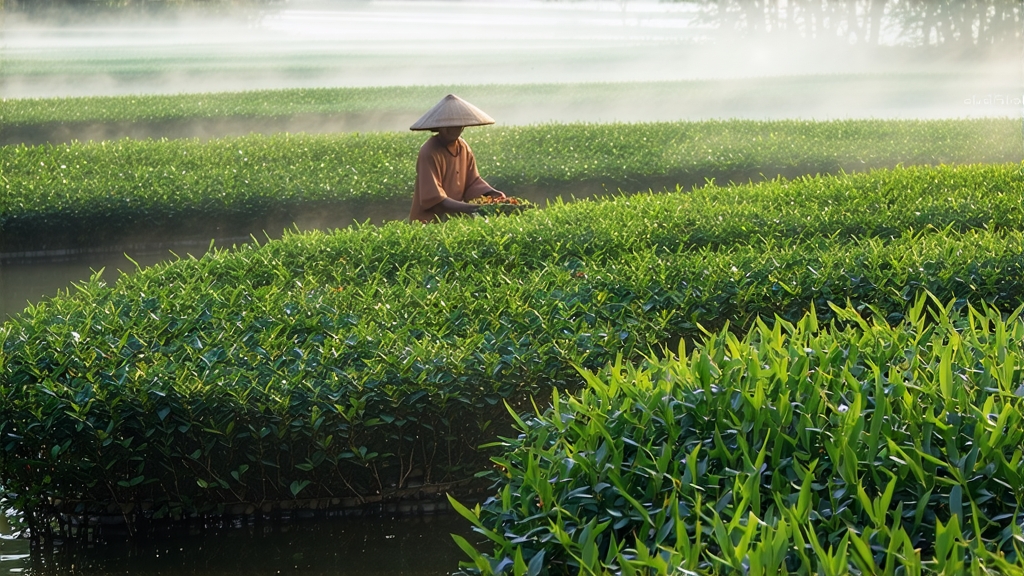
Longjing, literally “Dragon-Well,” is not merely a green tea; it is a liquid manuscript of Chinese history, landscape and craftsmanship. Grown in the hills that cradle Hangzhou’s West Lake, this celebrated cultivar has charmed emperors, poets and modern connoisseurs for more than twelve centuries. Its slender, jade-green leaves release a gentle, chestnut-sweet aroma that seems to distill the very breeze of early spring, making Longjing one of the first names international drinkers learn when they step into the vast universe of Chinese tea.
Historical scrolls from the Tang dynasty (618-907 CE) already mention tea picked around West Lake, but Longjing’s fame crystallized during the Ming dynasty. The Hongwu Emperor’s decision to abolish compressed tea and champion loose-leaf infusion elevated freshly pan-fired greens, and Longjing’s unique terroir quickly distinguished it from common fare. By the time the Qianlong Emperor of the Qing dynasty visited Hangzhou in 1751, he was so enamored of the tea that he allegedly pocketed freshly plucked shoots and brewed them back in Beijing, an anecdote still retold by local farmers. Imperial favor granted Longjing an almost mythical status; eighteenth-century court records list it among the “tributes” exacted from Zhejiang province, and the original eighteen bushes planted beside the Dragon-Well spring itself were declared state treasures, a designation they retain today.
Strictly speaking, authentic Longjing comes only from the Xihu (West Lake) appellation, a micro-region covering barely 1,600 hectares. Within this zone, five sub-areas—Shifeng, Meijiawu, Wengjiashan, Longjing village and Hupao—offer subtle variations. Shifeng, the highest ridge, yields leaves with orchid nuance and a mineral finish; Meijiawu produces a rounder, bean-like cup; Hupao, fed by the famous “Running Tiger” spring, gives a slightly sweeter liquor. Beyond Xihu, similar cultivars are grown in Qiantang, Yuezhou and even other provinces, but only West Lake Longjing may bear the regional seal introduced in 2001 to combat widespread counterfeiting.
The tea belongs to the small-leaf Camellia sinensis var. sinensis. Local heirloom strains—Longjing #43, Longjing Changye and the ancient Qunti zhong—are prized for their low bitterness and high amino acid content. #43, a clonal selection released in 1987, sprouts earlier and offers a photogenic emerald color, while Qunti zhong, the seed-propagated “group type,” develops more slowly and is valued for complex aromatics. Farmers often interplant osmanthus trees among the bushes; the shared pollinator habitat encourages biodiversity and is believed to influence leaf chemistry, though science has yet to quantify the effect.
Timing is everything. The plucking window opens around Qingming (early April) when nights are cool and days are misty. Pre-Qingming Longjing, picked before the solar term, can fetch over 2,000 USD per 500 g because the dormant buds have concentrated theanine and store winter sweetness. A skilled picker harvests only the standard “one bud with one unfolding leaf,” about 2.5 cm in length, tossing it into a woven bamboo basket lined with bamboo leaves to prevent bruising. Speed matters: the leaf must reach the village workshop within four hours to halt enzymatic oxidation.
Pan-firing (shaqing) is Longjing’s signature craft and the step that most shapes its flavor. Traditionally the leaves are tumble-tossed by hand on a cast-iron wok heated to 80-100 °C. The master’s palm reads the leaf temperature like a thermometer, adjusting pressure to press the shoots flat against the metal, creating the recognizable sword-shaped leaf while driving off grassy volatiles. A single batch takes twenty-five to thirty minutes, during which the moisture content drops from 75 % to roughly 20 %. The wok is then cooled to 60 °C for a second “hui guo” drying that sets the chestnut note and jade color. Apprentices spend three years learning to keep their bare hands in contact with 90 °C metal without flinching, a skill that has earned Longjing a place on China’s Intangible Cultural Heritage list. Modern factories replicate the process with automated drums, but the finest lots are still finished by hand to preserve the subtlest aromatics.
To brew Longjing authentically, begin with still spring water low in minerals; hard water dulls its brightness